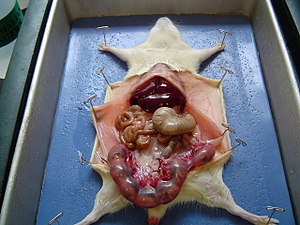Dissection
| Dissection | |
|---|---|

Dissection of a pregnant rat in a biology class
|
|

|
|
|
Anatomical terminology
[]
|
Dissection (from Latin dissecare "to cut to pieces"; also called anatomization), is the dismembering of the body of a deceased animal or plant to study its anatomical structure. Autopsy is used in pathology and forensic medicine to determine the cause of death in humans. It is carried out by or demonstrated to biology and anatomy students in high school and medical school. Less advanced courses typically focus on smaller subjects, such as small formaldehyde-preserved animals, while the more advanced courses normally use cadavers. Consequently, dissection is typically conducted in a morgue or in an anatomy lab.
Dissection has been used for centuries to explore anatomy. Objections to the use of cadavers have led to the use of alternatives including virtual dissection of computer models.
Plant and animal bodies are dissected to analyze the structure and function of its components. Dissection is practised by students in courses of biology, botany, zoology, and veterinary science, and sometimes in arts studies. In medical schools, students dissect human cadavers to learn anatomy.
Dissection is used to help to determine the cause of death in autopsy (called necropsy in other animals) and is an intrinsic part of forensic medicine.
A key principle in the dissection of human cadavers is the prevention of human disease to the dissector. Prevention of transmission includes the wearing of protective gear, ensuring the environment is clean, dissection technique and predissection tests to specimens for the presence of HIV and Hepatitis viruses. Specimens are dissected in morgues or anatomy labs. When provided, they are evaluated for use as a "fresh" or "prepared" specimen. A "fresh" specimen may be dissected within some days, retaining the characteristics of a living specimen, for the purposes of training. A "prepared" specimen may be preserved in solutions such as formalin and pre-dissected by an experienced anatomist, sometimes with the help of a diener. This preparation is sometimes called prosection.
...
Wikipedia
